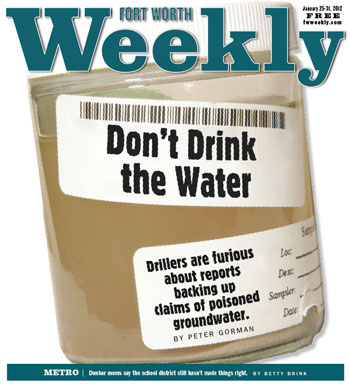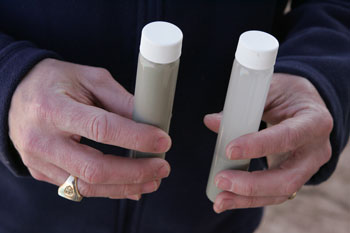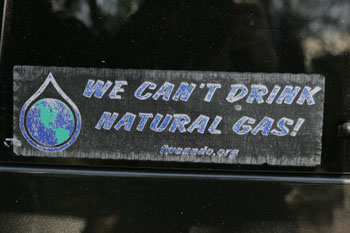When Jeff Locker looks out over his 1,500 acres of land just outside Pavillion, Wyo., he remembers what it used to look like: three horses in the corral, fields of barley and alfalfa bending in the breeze. These days the view from every window looks out over nearby shale gas wells, his own contaminated water wells, and an empty pasture: He stopped keeping horses after two of them died from nerve damage after drinking from a large plastic stock tank fed by his well. His wife is suffering from extreme neuropathy — he describes it a shooting nerve pain that radiates from the base of her spine or up her shins — that also came on after she drank the well water.
Locker is not alone in his problems. Louis Meeks lost cattle, horses, and sheep after they drank from contaminated stock tanks.
 And there are others. The sparsely populated gas field northeast of Pavillion has become a national focal point in the battle raging between the natural gas industry and those who say they’ve suffered severe damage due to that industry, from illnesses to contaminated groundwater to loss of property value.
And there are others. The sparsely populated gas field northeast of Pavillion has become a national focal point in the battle raging between the natural gas industry and those who say they’ve suffered severe damage due to that industry, from illnesses to contaminated groundwater to loss of property value.
Until now, the gas industry has been able to deflect much of the hue and cry over its alleged poisoning of groundwater sources. Drillers have claimed that there was never any proof that hydraulic fracturing — blasting millions of gallons of water mixed with sand and dangerous chemicals thousands of feet underground to blow open shale deposits to free trapped natural gas — has ever contaminated a single well. In those cases where it’s been apparent that the industry’s actions absolutely did contaminate water supplies — including several cases in North Texas — gas companies have simply bought the properties and had the former owners sign nondisclosure agreements, meaning they can’t say they’ve been bought out because of contamination.
But the argument began to change in 2009, when the Environmental Protection Agency decided to investigate the Pavillion gas field. The EPA action came at the urging of the Earthworks’ Oil and Gas Accountability project, people like Locker and Meeks, and the Powder River Basin Resource Council, an organization devoted to protecting Wyoming’s environment from irresponsible development.
The area was quickly designated an EPA Superfund site, meaning that it has been found to be contaminated with hazardous chemicals and that the EPA will try to determine who is responsible so that they can be legally forced to clean up the mess.
The EPA’s findings, released as a draft last month, clearly lay the blame at the feet of the gas industry and in particular, Encana Corporation, the gas field owner around Pavillion.
The agency found that natural gas and dangerous chemicals were migrating through local aquifers. More importantly the EPA discovered, via its own monitoring wells, that man-made chemicals used exclusively for hydraulic fracturing are showing up in the water.
In other words, these chemicals couldn’t have come from some sort of natural source or even another man-made source, but only from gas drilling. It was the first time that a direct scientific link has been made between gas drilling and groundwater contamination.
Not surprisingly, Encana and the industry are fighting back, arguing that the EPA’s findings are flawed on several grounds. The impact on their industry — and the worldwide natural gas supply situation — could be tremendous, if the EPA’s findings are upheld.
At stake are shale plays all around the country that have not been allowed to proceed until the gas industry proves it can drill without contaminating water supplies. Not to mention the blowback in places like Texas, where landowners across the Barnett Shale and other shale areas could conceivably use the EPA’s findings as a basis for damage suits and actions to prevent or stop drilling activities. The Natural Resources Defense Council has a list of 36 places around the country — including nine in the Barnett Shale — where landowners believe that gas fracking has contaminated their water wells.
One of those problem areas in North Texas, involving three homeowners in Hill County, stopped being a problem after the drillers, Williams Production–Gulf Coast Co., purchased all of the affected property. A second local case, involving possible contamination by Range Resources of water wells in Parker County is an ongoing legal battle.
Another contaminated property in North Texas is part of a broader review being conducted by the EPA to be released later this year. Drilling activist Tim Ruggiero said the land he formerly owned in Wise County is included in a review by the EPA of seven regions of the country, regarding fracking’s effects on groundwater. Ruggiero’s land was initially contaminated by a series of spills in 2009 and 2010. Eventually, his water well was poisoned with methane, and the gas also began bubbling up from other sections of his property.
“I don’t think any new science would have changed anything for my family,” he said. “We got them [the EPA] involved early on, but they didn’t even begin to do any testing until the second year of production.”
Deborah Rogers, who brought attention to drilling-related pollution on her Fort Worth-area goat farm several years ago, said she’s not surprised by the industry reaction. “Of course industry is [denying] it,” she said. “The industry stands to lose so much money now. They’ve kept this cat in the bag for so long they have nothing left to do but deny, deny, deny.”
Jerry Lobdill, a retired Fort Worth physicist who has long studied the gas drilling operations around Fort Worth, agreed. “The industry will try to ignore the EPA study and continue with the mantra that there has never been a proven contamination by a gas well. The industry is criminal.”
The groundwater contamination report could turn out to be only the first of several scientific body-blows to the industry. Scientists in Ohio have recently determined that an injection well — the industry’s main method for disposing of its toxic wastes — is the cause of 11 earthquakes there in the last year. The wells shoot the chemical-laden liquid, under extremely high pressure, into formations far below water-bearing strata.
That finding, in turn, comes on the heels of new concerns that sucking out so much gas, as well as extracting vast quantities of water from aquifers to use in drilling, could cause the ground above those aquifers and gas patches to settle. That might not matter much out in the country, but it would be devastating to urban areas that have been heavily drilled, like Fort Worth. In fact, one geologist said, the long history of oil and gas drilling and water extraction in the North Texas geologic zone that includes the Barnett Shale has already led to settling in some parts of the region.
The Powder River Basin, a high-plains region that spans northeast Wyoming and southeast Montana, is home to the largest coal reserves in the U.S. The high mountain desert is also ecologically important, providing habitat to 10 threatened or endangered species. Within the basin’s 24,000 square miles is the Wind River Indian Reservation, home to portions of the Northern Arapaho and Eastern Shoshone Tribes. The tiny town of Pavillion (population about 170) and its gas field lie within the reservation’s boundaries. Nearby reservation land, outside of the Pavillion gas patch proper, has also been heavily drilled.
 The geology of the area is a complex series of sandy crusts folded back on themselves, creating pockets of water and natural gas. Because of the sand pockets, groundwater is not a continuous aquifer. Gas migrates up through the sandy formations in plumes. According to a report by Encana Corp., that occurs because there is no solid cap rock between the deep natural gas deposits and the shallower water-bearing levels. Drillers have brought in gas wells as shallow as 1,100 feet.
The geology of the area is a complex series of sandy crusts folded back on themselves, creating pockets of water and natural gas. Because of the sand pockets, groundwater is not a continuous aquifer. Gas migrates up through the sandy formations in plumes. According to a report by Encana Corp., that occurs because there is no solid cap rock between the deep natural gas deposits and the shallower water-bearing levels. Drillers have brought in gas wells as shallow as 1,100 feet.
The first gas well was drilled in 1960. Locker, who has lived in the area his whole life and bought his current farm in 1988, said his well water was good until about 1998, when Tom Brown Inc., which owned the gas field, began replacing the casing on a well about 1,000 feet from his water source.
“One day while they were working out there, the well just went bad,” he said. “You couldn’t stand to smell it or taste it. I asked the fellow what he’d done to the water, and he denied doing anything. And it’s been a battle ever since.”
His well water “was fine for 10 years ’til it went bad, and when it went bad, it was almost overnight,” he said.
Locker and his family continued to bathe with the water, but he began hauling in drinking water — and kept hauling it for 12 years. At one point he even bought a $10,000 whole-house reverse osmosis unit to clean the contaminated water for bathing. “But I still wouldn’t drink it. Neither would my son. But my wife did. She thought the unit made it drinkable. But about six months after she started drinking it, she got very sick with extreme neuropathy.” That was more than five years ago, he said, and she’s suffered with it ever since. “Nerve damage doesn’t heal; it’s just a question of pain management.”
Encana bought the field in 2004. Between then and the end of 2007, the company drilled 44 new gas wells, bringing the total in the field to 125. The company also inherited several old production pits — large open-air pits dug to store drilling waste, much of it toxic — that Encana never used. The company discovered groundwater contamination seeping from those pits and in 2005 began trying to remediate the problem, a process that’s still going on.
But the presence of a big-name outfit like Encana didn’t put an end to the growing water well contamination in the area.
In late 2004, Meeks, a former gas and oilfield worker, said Encana “drilled a well 500 feet from my house. They completed it — fracked it — in January 2005, and in early February my water went bad.”
When Meeks complained to Encana, he said, the company immediately brought a water tank to his home and hooked it up. “They got the tank to me in March, I think, and they took care of all my house water needs. But then in October they decided it wasn’t their fault my well went bad, and they pulled the tank.”
Meeks brought in a private company to drill a new well, hoping the water would be usable. At the initial completion depth of 180 feet, the water was “horrible. It was filled with floating things, bad smell, just rotten. It was really just production water from the gas drilling.”
Meeks told the water well driller to go deeper. The well reached 540 feet and a new water pocket. “We decided to clean out the hole — we’d already dropped the casing pipe in and had it cemented — to see what kind of water we had,” he said. But when they’d cleaned out the drilling mud and old water with air pressure to about half the water well’s depth, foamy gas began coming up with the water.
“It was thick. If there was a spark, we would have died,” Meeks said. “It came up with the water, and it kept flowing, right over the top of the wellbore. ”
The escaping gas posed enough of a danger that the sheriff’s department closed three roads to keep traffic away. Three days after the gassy water began to escape, Encana plugged Meeks’ well.
“There was so much gas coming out of my water well,” Meeks said, laughing, “that when they plugged it, production on their three closest gas wells tripled.”
Even though he can laugh about it now, Meeks said the situation was terrifying at the time. He could see his home exploding at any minute — but he couldn’t get any help from either Encana or state agencies.
“They called me a troublemaker at first and then a liar,” Meeks said. “Encana actually told people I threatened to shoot the drillers. But I knew I wasn’t wrong. I worked the gas fields. They just didn’t drill this field right. The gas wells were communicating with the water wells. Gas was just flowing into the aquifers.”
Locker, Meeks, and others in the area formed the Pavillion Area Concerned Citizens group to try to get their problems taken seriously. The organization contacted the Powder River Basin Resource Council, which contacted Earthworks’ Oil and Gas Accountability Project. Together they were finally able to get the attention of the EPA.
In March 2009, the EPA sampled 39 private water wells in the area and two municipal wells. The municipal wells in the town of Pavillion several miles from the gas field were clean, but 11 of the private water wells were found to have traces of contaminants, including methane, oil, and metals. Three of the wells contained a chemical used in hydraulic fracturing. Residents in the area were told not to drink or cook with the water, and to open the windows in their bathrooms before showering to prevent explosions from a buildup of methane.
Encana, through the Wyoming Rural Water Association, began supplying drinking water to anyone in the area who requested it. Locker gets 75 gallons of drinking water every two weeks.
“Twelve years of hauling water, and the EPA shows up, and suddenly Encana can supply drinking water,” he said. “How about that?”
Shortly after the EPA’s initial report was released, Wilma Subra, the Louisiana biochemist who has been studying the health effects of gas drilling activities for years, conducted a voluntary health report in the area. What she found was an array of problems very much like what she’d already encountered in other shale gas areas, including the North Texas town of DISH and the Marcellus Shale in the northeastern United States.
“The health survey correlated the symptoms of people with the chemicals found in the drinking water and air associated with gas drilling. There were both acute and chronic symptoms, from rashes to headaches to neurological disorders and cancers,” she said. More than 90 percent of the survey participants reported symptoms that are known effects of the chemicals identified in the wells studied by the EPA.
Deb Thomas, spokesperson for the resource council, said that gas field residents were relieved and thrilled that the EPA came in.
“Some of those people had been trying for more than 10 years to get someone to pay attention to their problems, and they were continually told that there were no problems,” she said. “The fact that someone took them seriously, and that science was utilized to determine that something was indeed terribly wrong, was a vindication for them.”
********
The initial study of the Pavillion gas field was only the start for the EPA. In 2010 the agency declared it a Superfund site and decided to continue to keep tabs on the shallow water wells and to also drill two deep water wells of its own to monitor what was going on. Those wells were drilled to 775 feet, roughly the depth of the deepest domestic water wells in the area, but several hundred feet above the shallowest gas well.
The EPA found that several of the old production pits inherited by Encana were indeed contributing to groundwater contamination of the shallowest water wells, some of which are only about 100 feet deep. According to the EPA draft report released on Dec. 8, “high concentrations of benzene, xylenes, gasoline range organics, diesel range organics, and … hydrocarbons” were strong indications that the pits were causing part of the problem.
 The shallow groundwater con-tamination from the old production pits had been expected, but there were also problems with deeper water wells not associated with the pits. In several, the EPA “identified contaminants of concern,” including low levels of hydrocarbons and high levels of methane.
The shallow groundwater con-tamination from the old production pits had been expected, but there were also problems with deeper water wells not associated with the pits. In several, the EPA “identified contaminants of concern,” including low levels of hydrocarbons and high levels of methane.
While the levels of hydrocarbons and other chemicals were found to be “generally below established health and safety standards,” they were high enough to draw another agency’s concern. The Toxic Substances and Disease Registry, part of the U.S. Department of Health and Human Services, reviewed the EPA data and reiterated the warnings about not drinking the well water or cooking with it and ensuring there was plenty of ventilation while showering.
The EPA determined that the presence of the chemicals in the water was being caused by “migration from areas of gas production” and suggested three ways that migration might be occurring. They included compromised wellbores or poor wellbore casing, frack fluid flowing into porous sandstone formations, and the creation of new fractures or enlargement of existing fractures in the strata during the fracking process, allowing gas and frack fluids to migrate upward. The draft report did not attempt to determine which of the three mechanisms was responsible for the well contamination.
The most serious findings by the EPA came from its own deep monitoring wells. The water from those wells contained high levels of methane, benzene concentrations 50 times above Safe Drinking Water Act standards, and an array of synthetic chemicals “like glycols and alcohols consistent with gas production and hydraulic fracking fluids.”
The implications of the EPA findings could be vast for the gas industry and those who live near the gas fields. While drillers can rectify poorly constructed or compromised wellbores, if fracking can be proven to open up new fractures or widen existing ones, allowing gas and other chemicals to migrate upward and contaminate aquifers, public officials could decide to ban drilling altogether in some places. (Not of course, likely to happen in Texas, where the oil and gas industry wields such power.) In places like New York state, where gas companies want to drill near aquifers that supply New York and New Jersey with drinking water, public reaction against drilling is likely to be strong.
Recognizing the risks they face, the industry is fighting back. Editorials and guest columns on television and in newspapers and hundreds of industry web sites decried the study’s findings.
The Wall Street Journal, on Dec. 20, in an editorial titled “The EPA’s Fracking Scare,” pointed out alleged errors in the study and questioned the integrity of the EPA itself. “Nothing would shut down drilling faster, and destroy billions of dollars of investment, than media interviews with mothers afraid to let their kids brush their teeth with polluted water. So the EPA study needs to be carefully reviewed,” the editorial said. It went on to warn, “The agency is dominated by anti-carbon true believers, and the Obama administration has waged a campaign to raise the price and limit the production of fossil fuels.”
Encana essentially pooh-poohed the entire study. “The EPA found no domestic water wells that have any oil or gas impact,” Encana spokesman Doug Hock told Fort Worth Weekly. “They found traces of diesel range organics. And what was found on further investigation was that none of those diesel range organics were related to oil or gas. They also found methane. But there is a lot of methane near the surface there.”
Hock also derided the deep monitoring well findings. “The EPA dug two deep wells into a gas formation and found gas, which we think is normal,” he said.
He conceded that the production pits’ contaminants might affect shallow groundwater but insisted that they are not in proximity to the gas wells Encana itself has drilled. And, he said, “We’ve been working on remediation of those [pits] for some time.”
In a December press release the company claimed that many of the EPA’s findings from the monitoring wells are “conjecture, not factual, and only serve to trigger undue alarm.” Encana went on to suggest that some of the samples could have been compromised by sloppy collection and handling by the EPA.
Kim Feil, an anti-drilling activist from Arlington, said Encana’s reaction is par for the course. “I’m not even surprised that they [Encana] went so far as to say the EPA testers themselves probably caused the contamination they were reporting.”
The Encana release noted that the EPA’s findings have not yet been scientifically peer-reviewed and suggested they won’t hold up to scrutiny. The EPA responded to that charge by reiterating that the report is a draft, subject to a period of public questioning to be followed by scientific peer-review.
EPA spokesman Larry Jackson, in response to Encana’s charges, told the Weekly that “the deeper part of the drinking water aquifer used by Pavillion residents is highly contaminated with constituents that are best explained as resulting from gas production practices, including hydraulic fracturing … . The samples from the wells included not only petroleum-related compounds at very high concentrations, but also synthetic chemicals such as alcohols and glycols that do not occur naturally in groundwater, whether in proximity to a gas field or not. These chemicals are known to have been used in fracturing fluids in this field based on data provided by Encana.”
Richard Mylott, another EPA spokesman, said it’s important to note that “the draft report findings are specific to Pavillion, where … production conditions are different from those in many other parts of the country.”
Pavillion gas wells, for instance, are considerably shallower than those in the Barnett Shale, and they are vertical, not horizontal. Many in the gas industry suggest that even if the EPA findings hold up and a link is established between gas drilling and water contamination in Pavillion, it wouldn’t be applicable in areas of deeper drilling.
Officials with the Texas Railroad Commission, which oversees the state’s oil and gas industry, did not respond to an e-mail request asking whether the Pavillion study could affect drilling here. However, commission chairwoman Elizabeth Ames Jones is on the record as saying, “Hydraulic fracturing does not go on close to the surface here, and it would be impossible [for gas or drilling wastes] to migrate up from miles below the earth to the water table.”
Alisa Rich, owner of Wolf Eagle Environmental, which did the air studies for DISH and elsewhere, thinks that is nonsense. “Encana suggests that methane migrates in the Pavillion gas field naturally and leaves it at that. And yes, gas can migrate,” she said. “But most gas has to be stimulated to be released, particularly if the volume of gas increases substantially.”
That stimulation could be caused by underground tremors that open fissures in shale formations. But, Rich said, when water wells have historically never had methane contamination, and suddenly there are large volumes of methane coming up with the water near hydraulic fracking, “then there is a fairly logical hypothesis that can be made that that stimulation had an effect on the geology to cause those increases.”
Even with the deeper gas wells typical in the Barnett, stimulation through fracking could produce the same result, she said. “If someone fracks below an aquifer and that aquifer doesn’t have a confined bottom — if it’s contained in sandstone, for instance — the gas set free could very well migrate up and into that aquifer.”
Rich noted that it would be almost impossible for the man-made chemicals found in the water from Pavillion’s deep monitoring wells to have gotten there except through fracking.
Dozens of cases have been reported around the country of water wells getting contaminated from deep fracking. Amy Mall, a staff member of the National Resources Defense Council, keeps an ongoing list of such contamination reports. Of the 36 cases detailed on her blog, nine are in the Barnett Shale.
 “And those are only the cases where people made a public issue of it,” Mall said. “So often we don’t hear about water contamination because the gas companies responsible make a settlement with the affected well owner that includes a non-disclosure agreement.”
“And those are only the cases where people made a public issue of it,” Mall said. “So often we don’t hear about water contamination because the gas companies responsible make a settlement with the affected well owner that includes a non-disclosure agreement.”
How many more cases are out there? A Scientific American article published last October cited a Duke University study from earlier in 2011 that found “methane levels in dozens of drinking-water wells within a kilometer [3,280 feet] of new fracking sites were 17 times higher than in wells farther away.”
Calvin Tillman, the former mayor of DISH, at the epicenter of the Barnett Shale, said that he’s glad the EPA has finally gotten into the fray. “I think it’s a big step for a governmental agency to come out and show what everybody has been thinking,” he said. “No one ever had the smoking gun before, and we do. Hopefully that will help improve situations around the country where gas is being drilled.”
Sharon Wilson, coordinator for Earthworks’ Texas Oil and Gas Accountability Project and author of the BlueDaze: Drilling Reform web site, said she’s glad that the EPA’s Pavillion study was done. But, she said, “None of this stuff is new to people who live in the gas patch. We know that gas drilling is contaminating our water and our air. The problem is that ordinary people cannot afford to bear the burden of proof against the richest industry on the planet.”
Wilson sees the EPA’s Pavillion study as a first step in shifting the burden of proof from the affected citizens to the industry, “where it should be. Private citizens shouldn’t have to spend millions of dollars to prove that industry polluted their water.” If the gas industry comes in and pollution follows closely on their heels, she said, “it should be on the backs of the industry to prove that they didn’t cause it.”
She cited the Parker County case, where Range Resources is accused of polluting water wells so badly that residents’ tap water became flammable. “The EPA simply shifted the burden onto Range by issuing an ‘imminent and substantial endangerment’ order and told Range they had to prove they had not polluted those wells.
“The industry claims to have a record of clean work,” she said. “What they really have is a record of pollution and non-disclosure agreements.”
Drilling itself is far from the only source of environmental troubles posed by the shale gas industry. There are two other areas where recent developments are undercutting the industry’s denials of environmental damage — and strengthening the resolve of activists. Both concern what drilling is doing to the stability of the ground itself.
********
The quake in Youngstown, Ohio, hit on New Year’s Eve, but its effects could reverberate far longer and further than the temblor itself.
The 4.0 magnitude quake originated directly below an injection well. The next day, the Ohio Department of Natural Resources shut down the well. It was the 11th earthquake originating below the well site since March 2011 and the strongest.
Injection wells have been suspected of causing earthquakes in Oklahoma, Arkansas, and North Texas, but the Youngstown well was the first to be outfitted with sensors to actually track that relationship.
John Armbruster, a seismologist with the Lamont-Doherty Earth Observatory at Columbia University, was involved in interpreting the findings. “The well opened in December 2010, and the first earthquake occurred three months later,” he said. “In November 2011, after the ninth earthquake happened, Ohio officials asked the university for scientific help.”
Armbruster and his colleagues installed four seismographs in the area. “And then on Christmas Eve and New Year’s Eve when we recorded earthquakes, we were able to determine that their epicenters were about 3,000 feet directly below where the gas wastewater and chemicals were being injected,” he said.
His team at Columbia monitors earthquakes in New York, Pennsylvania, Vermont, Connecticut, and New Jersey. Experience, he said, has drawn his team to “understand the connection between injection wells and earthquakes. Simple reasoning makes you ask if that connection is possible. And as a scientist I have to say this link is accepted.”
Not every injection well is likely to cause quakes, Armbruster said — it depends on the geology. The Youngstown well was operating “only one kilometer from where some earthquakes were waiting to happen. It was an unlucky well.”
On the other hand, he said, every such well should be watched. “If it was up to me, I would monitor every injection well closely, and at the first sign of a [small] earthquake, I’d have them shut down before there were larger ones.
“Right now we’re in a situation where you inject into the well, and if it cries out with earthquakes, then you react,” he said.
The injection wells are more likely to cause quakes than the gas wells themselves, the seismologist said, because the waste-disposal wells are drilled so much deeper.
He also noted another potential geological danger associated with gas drilling. In areas where there has been heavy drilling or where huge quantities of water have been removed from an aquifer, the land might subside.
“Try to picture Southern California’s Imperial Valley. They’ve sucked so much water out of the aquifer there for so long that the entire valley has sunk about 30 feet,” he said. “I have not studied the Fort Worth situation, but it’s not impossible that there might one day be potential geological problems with sucking so much gas and water from beneath the city. If it settled, let’s say, 20 feet, certainly that could potentially cause serious problems. Would floors crack? Walls crack?”
The issue hasn’t gotten much coverage, but it’s not new either. More than a decade ago the U.S. Geological Survey released a paper noting that more than 17,000 square miles in 45 states had been affected by land subsidence and pinpointing water extraction as a cause of 80 percent of that. But mining for hydrocarbons was also mentioned as a reason: Subsidence in the Goose Creek oilfield near Galveston was first noted in the mid-1920s, for instance.
Fracking for gas severely affects the underground pressure of both aquifers and gas-bearing shale. On average, it takes three to five million gallons of water to frack a well in the Barnett Shale, and then huge amounts of gas are extracted, changing the pressure levels in underground geologic formations.
“It’s certainly possible that you’re going to have subsidence problems in Fort Worth,” said Lynn Highland, a geographer with the U.S.G.S. She said it is very difficult to predict where it would occur because of the time and expense needed to study the underground geology of an area. “But when you take that much water out of the ground and that much gas, you’re changing the integrity of what’s going on with the geology,” she said. “And once you do that, let’s just say that homeowners quickly find out that they’re generally not covered by homeowner’s insurance when subsidence occurs.”
Mark Engle, a research geologist with the same agency, said that subsidence is already happening in the Fort Worth Basin, a region that’s been heavily drilled for oil and gas for a long time, with fracking only the latest new twist. “So the question is how much more will occur because of hydraulic water fracturing? There is no way around the fact that we’re removing the infrastructure of the geology.”
********
In January 2011, Encana asked the EPA to suspend public comment on the draft report because the company did not get all of the data the EPA had used in compiling it. Two weeks later, the Pavillion Area Concerned Citizens wrote to the EPA urging the agency to continue its investigation in the area. That sentiment was supported by both Earthworks’ OGAP and the Powder River Basin Resource Council.
In their letter, Gwen Lachelt, director of Earthworks’ OGAP, called the accusations that the EPA is withholding data “a political ploy to cover up the results and bring a halt to the study. We’ve seen this time and again with industry shirking responsibility and the government turning its back on the people who bear the impact of energy development in our country.”
“The people of Pavillion are living on a pool of bubbling, frothing, toxic chemicals,” said Powder River spokesman Thomas. “It’s a very dangerous situation. I strongly believe that all those affected should have the opportunity to leave if they want to leave.”
“Everybody says I should leave,” Meeks said. “I know I should leave. But where would I get the money to buy another place? Everything I’ve got is wrapped up in this place, and I couldn’t sell it because it’s worthless now. And I’m angry. I have nothing against oil and gas if it’s done right. But done the way it’s been done here, well, it’s a human-rights violation.”
Longtime Fort Worth activist Don Young, who sounded the alarm on gas drilling when it first began here, isn’t surprised by either the pollution left in the wake of the gas drilling at Pavillion or the industry’s howls.
“I’m glad the EPA is there, and I hope they keep their investigation going, but what the industry is doing, and has always done, is plant the seed of doubt in the public’s mind: ‘The water is not our problem. Air contamination is not our problem. Earthquakes are not our problem.’ And it’s been an effective campaign, even though it’s a lie.
“I’m glad to see the EPA is finally planting a seed itself, that there is a connection between the contamination and the drilling,” he said. “It’s too bad those people had to suffer like that before that connection was made.
“What I said years ago remains true today: We can’t drink natural gas.”












I’m gone to inform my little brother, that he should also pay a quick visit this web site on regular basis to take updated
from hottest news update.
[…] drinking water, but a draft is not expected until late 2014. Meanwhile, last month the agency issued a report showing apparent fracking-related contamination of wells in Wyoming. In any case, overall, funds for studies have remained thin. So for now, […]